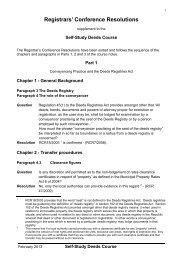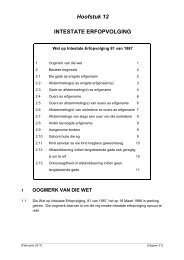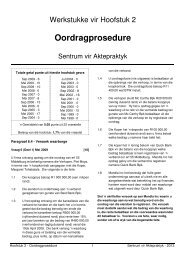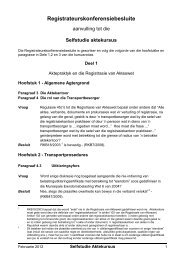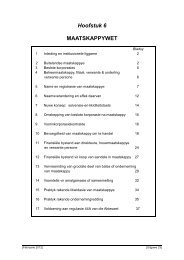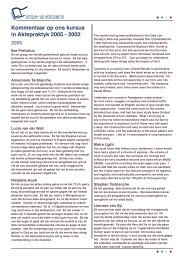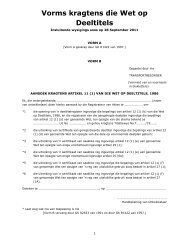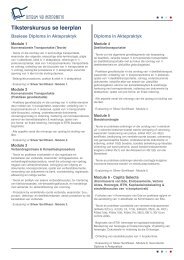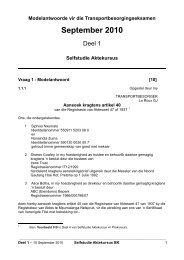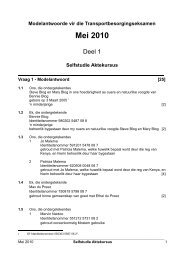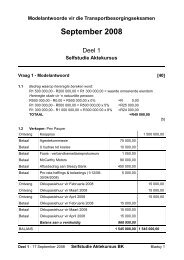Conference Resolutions - Centre for Conveyancing Practice
Conference Resolutions - Centre for Conveyancing Practice
Conference Resolutions - Centre for Conveyancing Practice
Create successful ePaper yourself
Turn your PDF publications into a flip-book with our unique Google optimized e-Paper software.
Resolution The whole of the property must be made subject to the conditions of the will -<br />
(RCR27/2006).<br />
Paragraph 5.4 Supporting documents <strong>for</strong> estate transfers due to inheritance<br />
Proof of intestacy<br />
Question Can a death notice be accepted, amongst other things, as proof of intestacy?<br />
Resolution<br />
1 A death notice may be accepted as proof of death but not as proof of<br />
intestacy or proof of descendants and ascendants.<br />
2 For proof of heirs, including illegitimate children (children born out of wedlock),<br />
an affidavit of next-of-kin must be called <strong>for</strong>. 20<br />
Question Given the fact that a death notice cannot be accepted as proof of intestacy (that<br />
a person died without leaving a valid will), what proof should be required?<br />
Resolution<br />
1 Proof, in the <strong>for</strong>m of an affidavit from the executor / representative, must be<br />
insisted upon.<br />
2 However, in the case of a transfer by endorsement in terms of section 45 of the<br />
Deeds Registries Act 47 of 1937 a regulation 49(1)(g) certificate from the<br />
Master will be acceptable - (RCR3/2007).<br />
Affidavit of next-of-kin as proof of heirs<br />
Question In RCR7/1997 it was resolved that <strong>for</strong> proof of any further heirs, (including<br />
children born out of wedlock) an affidavit of next-of-kin must be called <strong>for</strong>. Does<br />
this mean that an affidavit of next-of-kin must be called <strong>for</strong> in all cases where the<br />
testator nominates his/her children as heirs without identifying them as well as<br />
children born out of wedlock?<br />
Resolution Yes. RCR7/1997 is confirmed. In all cases mentioned above, an<br />
affidavit of next-of-kin must be lodged - (RCR11/2005).<br />
Question The Master only requires that an affidavit of next-of-kin be filed in cases where<br />
the deceased did not leave a valid will. There are cases where wills bequeath<br />
property to “my child or children”. How should these children be proved?<br />
RCR5/2007 provides that an affidavit of next-of-kin must be called <strong>for</strong> to prove<br />
heirs (intestate or testate). What if there is no affidavit of next-of-kin filed at the<br />
Master? Can the liquidation and distribution account be accepted as proof?<br />
Resolution No, the liquidation and distribution account is not acceptable. An affidavit of<br />
next-of-kin must be lodged - (RCR9/2008).<br />
RCR 9 of 2008: Proof of unnamed testate heirs<br />
Question What is the position if an affidavit of next-of-kin is not filed with the Master and<br />
the Master does not want to accept a new next-of-kin affidavit? Can the original<br />
next-of-kin affidavit be accepted and will this not be in contravention of regulation<br />
50 of the Deeds Registries Act?<br />
20 In RCR7/1997 <strong>Conference</strong> resolved that a death notice can be accepted, amongst other things, as proof of<br />
intestacy. In RCR28/2006 <strong>Conference</strong> resolved that a death notice cannot be accepted as proof of intestacy. In<br />
RCR5/2007 the latter resolution, 28/2006 was confirmed and RCR29/1996 and RCR7/1997 were withdrawn.<br />
February 2012 Self-Study Deeds Course<br />
20



